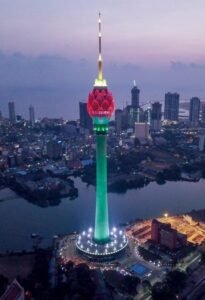
Bentota
April 7, 2025
Kuchchaveli
April 7, 2025
Bentota
April 7, 2025
Kuchchaveli
April 7, 2025
Polonnaruwa
Nestled in the heart of Sri Lanka’s Cultural Triangle, Polonnaruwa is a UNESCO World Heritage Site that showcases the ancient grandeur of Sri Lanka’s civilization. As the island’s second capital, Polonnaruwa is home to an impressive collection of historical ruins, stunning temples, and fascinating archaeological sites. Whether you're a history enthusiast, a culture lover, or someone simply seeking a glimpse into Sri Lanka’s ancient past, Polonnaruwa offers an unforgettable experience that transports visitors to a bygone era.
Why Visit Polonnaruwa?
Polonnaruwa is a treasure trove of history, offering a rare chance to explore the remains of an ancient city that thrived between the 11th and 13th centuries. The city is famous for its well-preserved monuments, intricate sculptures, and lush surroundings. The sites here offer deep insights into the architectural genius of ancient Sri Lanka, the grandeur of its kings, and the spiritual significance of the city during its heyday.
Unlike other ancient cities, Polonnaruwa is spread across an accessible and compact area, making it easy to explore on foot or by bicycle, giving visitors an intimate experience of the city’s historical charm.
Top Attractions in Polonnaruwa
- Gal Vihara – The Rock Temple of Polonnaruwa: One of the most iconic sites in Polonnaruwa is the Gal Vihara, a rock temple featuring four impressive Buddha statues carved into a granite rock face. The largest of the statues, a reclining Buddha, is particularly breathtaking. The serene expression on the Buddha’s face and the sheer size of the statues are a testament to the skill and devotion of the ancient sculptors. The intricate carvings and peaceful ambiance make this a must-visit for anyone exploring Polonnaruwa.
- Royal Palace Complex – The Heart of Polonnaruwa: The Royal Palace of Polonnaruwa was once the magnificent home of the kings who ruled the city. Today, visitors can wander through the ruins of this grand complex, which includes the king’s audience hall, bathing pools, and the queen’s quarters. The palace complex offers a glimpse into the royal lifestyle during the city’s golden age. Don't miss the king's council hall, where visitors can imagine the administrative and cultural affairs that took place within these grand walls.
- Parakrama Samudra – The Ocean of King Parakramabahu: The Parakrama Samudra, also known as the Sea of Parakrama, is an enormous reservoir built by King Parakramabahu I in the 12th century. It is one of the largest irrigation systems ever built in Sri Lanka and is an engineering marvel. The reservoir, surrounded by lush greenery and wildlife, is a peaceful spot where visitors can relax and enjoy the scenic beauty while learning about the ancient water management systems that were critical to the prosperity of the kingdom.
- Vatadage – The Circular Relic House: The Vatadage is a circular structure that once housed sacred relics. Known for its fine stone carvings and intricate architecture, the Vatadage remains one of the best-preserved structures in Polonnaruwa. It features a series of finely carved stone pillars, each with detailed inscriptions and symbols. The Vatadage is an architectural masterpiece, and visitors can marvel at the structure's design, which reflects the importance of religious artifacts in Sri Lanka’s ancient kingdoms.
- Lankatilaka Temple – A Massive Buddhist Temple: The Lankatilaka Temple is one of the most significant Buddhist structures in Polonnaruwa, featuring a large statue of Buddha surrounded by stunning murals. The temple is renowned for its towering architecture, with tall stone walls that still stand today. The temple is set within an open courtyard, and visitors can admire the grandeur of the structure and the ancient Buddhist artwork that adorns the interior walls.
- Shiva Devalaya – The Hindu Temple: In addition to its Buddhist sites, Polonnaruwa is home to the Shiva Devalaya, a well-preserved Hindu temple dedicated to Lord Shiva. The temple's intricate carvings and the serenity of the site provide a peaceful and reflective atmosphere for visitors interested in Sri Lanka’s multi-religious heritage.
- Archaeological Museum of Polonnaruwa -The Archaeological Museum of Polonnaruwa provides an excellent overview of the city’s history, offering a collection of artifacts, sculptures, and relics from the ancient city. The museum provides insight into the cultural and religious significance of Polonnaruwa and enhances the experience of visiting the ancient sites.
Best Time to Visit Polonnaruwa
The best time to visit Polonnaruwa is during the dry season, from December to April, when the weather is sunny and ideal for sightseeing. The cooler months of December and January are especially popular for exploring the city, as the temperatures are more comfortable for outdoor activities. While Polonnaruwa is open year-round, it’s best to avoid visiting during the monsoon season, from May to October, when the weather can be unpredictable.
How to Get There
Polonnaruwa is easily accessible from Colombo (approximately a 5-hour drive) and Sigiriya (about a 1.5-hour drive). You can reach the city by bus, taxi, or private vehicle, with several tours available from nearby towns. Trains from Colombo and Kandy also run to Polonnaruwa, offering a scenic and comfortable option for travel.


